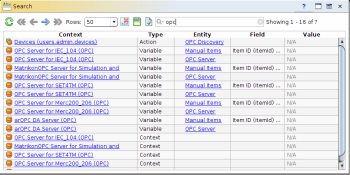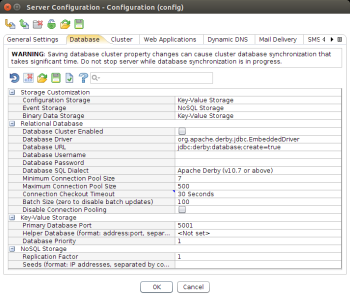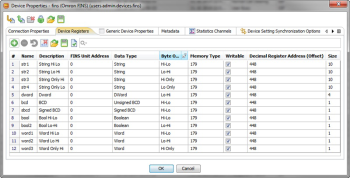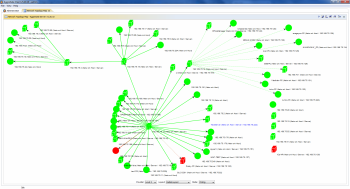AggreGate 5.2 comes with Unified Search and Big Data Storage
Being the first major release in 2015, AggreGate 5.2 delivers Big Data support, unified search capabilities, Business Intelligence (BI) engine, C/C++ Agent SDK and other valuable core features, as well as improvements of all vertical market extension packs including Network Manager, SCADA/HMI, and other.
Full-text search
AggreGate 5.2 got a unified search window that digs data across the whole system and instantly provides results based on a pre-indexed database. Now you can find devices by their IP addresses, locate variables by name, description and even by value. The highly customizable search robot indexes contexts, variable/function/event/action definitions, as well as variable values. Search results immediately reflect system changes.
Business Intelligence Engine
New AggreGate brings a whole new level of intelligence to the Platform by introducing two new core modules:
- Mass object management
- Object dashboards
Ideas and technologies behind the BI engine are very generic and flexible. The engine allows implementing new business objects (such as assets or maintenance orders), add attributes to them, and store millions of object instances in a relational database to allow quick browsing, searching and filtering. The objects may have one-to-one, one-to-many and many-to-many links to each other. This allows building Object Dashboards that visualize object instance properties, allowed lifecycle transitions, and linked objects lists.
The BI engine allows AggreGate to cover functionality of various business data management systems:
- Network Inventory
- Asset Management
- Data Center Information Management
- Service Desk
- Maintenance Order Management
- And many more
Despite the BI engine is available in experimental mode, its future support is guaranteed and all found issues will be resolved on highest priority basis. Our Partners are welcome to request detailed information about the BI module.
Big Data Support
AggreGate platform keeps up with the mainstream and now allows NoSQL databases to be used as configuration and event storage. Apache Cassandra and BerkleyDB Java Edition being used together (instead of a relational database) ensure extremely fast persistent configuration updates (20-50 K updates per second on a conventional server) and very high history/event storage rates (10-20 K samples per second, also on a typical low-cost server). Both databases support failover clustering for high availability and regular clustering for scalability.
C/C++ SDK
Our modular technology allows AggreGate Agent and even full-blown AggreGate Server to run on single-board PCs like Raspberry Pi and BeagleBone Black. But we’ve moved even closer to low-cost devices like Arduino by implementing AggreGate C/C++ SDK. The SDK helps to embed Agent library into C/C++ code that makes the device natively compatible with AggreGate. It also includes API for interfacing the server in a “client mode”, allowing full server control from within any C/C++ application.
Steady State Mode
AggreGate operators can now perform everyday duties in Unified Operations Console using a new Steady State mode. This mode disables access to the operating system making Console the only application allowed running. Combined with Simple Mode and Auto Run, the Steady State mode makes sure that users and operators get to custom AggreGate dashboards right after OS startup. This mode is suitable for touch panel applications, kiosks, and critical SCADA installations.
New Video Streaming Protocols
Video player UI component now supports more than one hundred video stream formats and codecs, including RTSP protocol, all codecs based on FFmpeg library and H.264 protocol. This delivers wide video source support and better picture quality through the use of more sophisticated stream encoding schemes. You can connect to almost any video camera or video server. You can play local video files on events, too.
New Device Drivers
Here are newly arrived drivers:
- Local Agent. Effectively makes AggreGate Server to act as an Agent. It collects entities (variables/functions/events) from other local devices and/or system resources and exposes those entities to another AggreGate Server by connecting to it as an Agent.
- Local System. Provides system parameters monitoring of the AggreGate server machine: CPU, Disks and Memory measurements.
- Omron FINS. Provides reliable way to connect Omron FINS Ethernet devices to AggreGate system.
Improved Network Topology Discovery
L2 network discovery algorithm is significantly improved to rely on Link Layer Discovery Protocol (LLDP) and Cisco Discovery Protocol (CDP). Those protocols enable accurate detection of switch-to-switch and switch-to-router connections, as well as connections between switches and other network devices. Topology visualization module has been also extended to support new tree and balloon layouts.
Graph Layout Saving
Many partners and customer will appreciate the long-waited transparent graph layout saving feature. A Graph UI component is enhanced to automatically save its current visual layout. A user can manually edit node positions by drag-and-drop and layout info will get persistently stored on the server. When a widget with a graph component is opened next time, graph layout is restored to the last saved state. You're welcome to create your own customized network topology maps!
Get AggreGate IoT Platform 5.2




